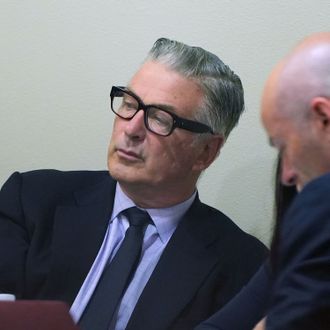
Alec Baldwin’s Santa Fe manslaughter trial veered into uncertain territory on Friday, July 12, when his lawyers asked the judge to toss the case over authorities’ alleged withholding of key evidence from the defense. Lawyers for Baldwin, who is charged with involuntary manslaughter in the death of Rust cinematographer Halyna Hutchins, claim that police didn’t disclose evidence that could explain how live bullets wound up on the movie’s set. The failure to disclose this evidence resulted in the judge dismissing the case with prejudice. Here’s how it happened.
The revelation first came on July 11 during the cross-examination of crime-scene tech Marissa Poppell, and was detailed in a subsequent motion to dismiss. Judge Mary Marlowe Sommer agreed to have a hearing about Baldwin’s push to dismiss; Seth Kenney, who provided guns, dummy rounds, and blanks to the production, was the first to testify. When law enforcement on Baldwin’s case took the stand, things went downhill for prosecutors — with the top cop saying that she and prosecutors agreed to put this evidence in a different case file, a move that the defense contends was tantamount to a cover-up.
Baldwin’s lawyers argued in their motion that the Santa Fe Sheriff’s Office and prosecutors “concealed” that the live round came from Kenney. The high-profile legal team then laid out a shocking chronology: Troy Teske, a retired police officer from Arizona, had “delivered a collection of live ammunition” to Poppell. Baldwin’s lawyers claim that the type of live ammunition matched “the live bullet that killed Hutchins.” Teske turned over the ammo after Rust armorer Hannah Gutierrez-Reed was found guilty of involuntary manslaughter on March 6, 2024.
According to the defense’s motion, authorities knew that Teske had information about Rust set ammunition for years. Kenney called Teske — who, like Kenney, was friends with Gutierrez-Reed’s father, famed armorer Thell Reed — during a police interview on November 1, 2021; after this sit-down, Teske sent authorities a photo of ammunition that didn’t match rounds found on the Rust set. Kenney then sent this photo to the then-case detective. In an interview with Teske the next day, a prosecutor asked him to provide ammunition from a batch Kenney had used elsewhere. Teske said he would turn it over, and the prosecutor said she would coordinate its collection, but authorities didn’t follow up.
Here’s where things get even messier: The defense said that Poppell’s supervisor told her to log the rounds “under a different case file so that it would never be disclosed to the defense.” The Sheriff’s Office didn’t disclose the rounds even though it has to disclose evidence to lawyers, even after Baldwin’s team asked to view all ballistics evidence. Poppell also said that the Sheriff’s Office created a report about the rounds “that also was never disclosed to the defense.” The defense described this as a “cover-up” in the motion.
“Baldwin was unaware of a risk that live ammunition had been brought to the set of Rust. To support its theory that Baldwin should have known of that risk, the State is attempting to establish a link between Baldwin and the source of the live ammunition,” the motion stated. “The only way it can do this is by demonstrating that the live rounds were brought to the set by the movie’s armorer, given the State’s assertion that Baldwin should have been aware of her youth and inexperience and therefore the possibility that she brought live rounds to set.”
“Evidence that the live rounds came from Kenney is therefore favorable to Baldwin, which is why the State buried it. The State not only failed to disclose the evidence — it affirmatively hid it under a file number that is unaffiliated with the Rust case and then failed to disclose the only documentation that it claims to have created that would have alerted Baldwin to the existence of the evidence,” the motion also stated.
During Kenney’s testimony in the hearing, he insisted that he’d handled tens of thousands of dummy rounds during his career without incident. He insisted that the live ammo on set did not come from him. “There was never a question in my mind that I provided the live ammunition to Rust,” he said.
The prosecution was dealt multiple blows when Alexandria Hancock, who headed the Rust investigation, repeatedly stumbled when being asked about authorities’ handling of Teske’s disclosure. In a shocking moment, Hancock said that she, other police, and prosecutors agreed to put this information in a separate file.
The judge asked: “Was Ms. Morrissey part of that?”
Hancock answered yes.
In a startling turn of events, Morrissey called herself to testify at the hearing. Morrissey delivered her direct testimony as a monologue and recognized that she did know about Teske’s disclosure, but insisted that the ammunition’s placement in a different file was not nefarious. “I had no idea that it wasn’t going to have the same case number.”
During cross-examination by Baldwin attorney Alex Spiro, Morrissey said of the filing issue: “I’m not a law enforcement officer, and I don’t work at the sheriff’s department.” Spiro then grilled Morrissey about her views of Baldwin. “You thought Mr Baldwin was a cocksucker?” Spiro asked, referring to an alleged comment to a witness. She said she didn’t recall saying that and without more information. “Did you call him an arrogant prick during a witness interview?” Spiro pressed. Morrissey said she didn’t recall saying that.
When Spiro effectively asked whether she had it in for Baldwin, Morrissey said, “That is absolutely untrue – I actually really appreciate Mr. Baldwin’s movies, I really appreciated the acting that he did on SNL, and I really appreciate his politics.”
Prosecutors claimed that Hutchins’s death resulted from Baldwin’s recklessness, telling jurors that he flouted common-sense gun-safety principles by pointing the gun at her and pulling the trigger. Baldwin’s team said the actor was told it was a cold gun, meaning it didn’t have live ammunition — and that he wasn’t reckless but simply handled the weapon as countless actors have and continue to do while filming. The defense repeatedly brought up alleged issues with evidence; they said the gun was destroyed during police analysis, making it impossible for them to determine whether it malfunctioned. They also argued that authorities were more concerned with nabbing Baldwin than they were thoroughly investigating the tragic incident. After hearing testimony about the evidence, Judge Sommer agreed with the defense when she issued her decision Friday afternoon, making Baldwin a free man.


